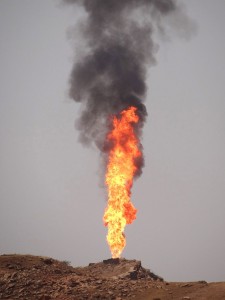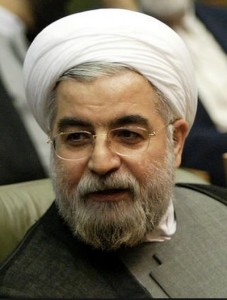Daan Bijwaard, 17 July 2014
No matter what the outcome of the Ukrainian crisis will be, it seems certain that the relations between the European Union (EU) and Russia will remain frosty for the foreseeable future. This will in particular influence the EU’s energy policy. The EU’s dependence on Russian gas is high on the political agenda since in 2009 an argument between Russia and Ukraine led to the gas pipelines between the two countries being cut-off for two weeks, threatening the supply of Russian gas to the EU. Now we will see increased efforts to reduce the EU’s dependency on Russian gas, with some formerly unconceivable options on the table.[1] One of these less obvious energy diversification options for European countries may be importing gas from Iran, a country long seen as an enemy of the West, but with the world’s second largest gas reserves.[2]
Energy diversification will not be an easy task for the EU. The EU member states obtain in total about 25% of their gas from Russia (for Germany, the biggest importer, this figure is 40%), good for about 160 billion cubic metres of gas. Moreover, the EU’s import dependency is expected to grow, as its own gas reserves are dwindling and the European demand for gas is growing[3]. Replacing Russian gas with European shale gas or renewables will take many years, huge investments and, in the case of shale gas, is controversial. Importing American shale gas is also considered as a serious option, but currently the United States lack gas export facilities.[4] Additionally, the growing demand for gas in Asia drives up the worldwide market price of liquefied natural gas (LNG) from countries like Qatar or Algeria.[5] This means that less obvious sources of gas become interesting, such as Iran.
Iran does not appear to be the most likely energy partner for Europe. Just two years ago, in 2012, the EU banned Iranian oil imports and froze the assets of the Iranian Central Bank.[6] However, recently the mutual antagonism between the West and Iran seems to make way for a more pragmatic attitude. Iran’s negotiations with the P5+1 – the five permanent members of the United Nations Security Council plus Germany – to reach a final deal regarding Iran’s nuclear program, appear to be moving slowly ahead since the election (in August 2013) of Hassan Rouhani as Iran’s President.[7] Rouhani, is seen as a moderate, who wants to improve relations with Western countries, in order to soften the Western sanctions regime and improve Iran’s frail economy.
The Iranian government appears to believe that it can use the European addiction to Russian gas to improve its political position in the world and solve its economic problems.[8] Already on 4 December 2013, Iran named seven Western oil companies it wants back in Iranian gas fields if international sanctions are lifted.[9] In an interview on 14 April this year, less than a month after the Russian annexation of the Crimea, Tehran’s industry minister, Mohammad Reza Nematzadeh, said in an interview with the German newspaper Handelsblatt that Iran would like a part in Europe’s increasing demand for gas.[10]
It is not to be expected that Iranian gas will start flowing to the EU soon. First of all, many technical problems will need to be overcome. It will take time to build the required infrastructure to transport Iranian gas to Europe. The experience in Qatar has shown that building gas export infrastructure can take many years, even for a wealthy country (which Iran is not).[11] For the moment, Iran still has to decide if it will opt for building gas pipelines to Europe through Turkey, or will invest in building LNG facilities to transport gas to Europe by ship. It can be doubted if Iran has sufficient technical and financial resources to develop its gas reserves to such an extent that it can both meet the growing demand of its own 80 million strong population and export substantial amounts of gas. Many experts believe that Iran can only develop its gas export capabilities with the knowledge and investments of Western energy companies.[12] However, it is questionable if Western energy companies are willing to invest billions in a country which has still a very fragile relationship with the West.
This brings us to the second important obstacle to the possibility of Iran exporting gas to Europe on a large scale; the lack of mutual political trust. On the one hand, even if an agreement will be reached on Iran’s nuclear programme, the West will be likely remain reluctant to cooperate with a country that supports the Assad regime in Syria and has a bad human rights record. On the other hand, it is doubtful if Iranian political hard-liners, including Iran’s influential ‘Supreme Leader’, Ali Khamenei, are willing to allow Western companies access to the Iranian energy industry. It can even be questioned if hard-line factions in the Iranian establishment want to cooperate with the West at all. Moreover, Iran has substantial commercial and military ties with Russia, and is an ally of Russia in the Syria conflict.[13] This means that Tehran will likely be wary to offend Moscow by signing gas contracts with EU member states.
Altogether, it seems improbable that Iran will be able to replace Russia as the EU’s largest gas supplier, also in the medium to long-term. However, it is not unlikely that Iran will feature in the EU’s energy policy options. In 2035, Europe will need to import 80% of its gas and may need to import up to 450 billion cubic metres of gas every year.[14] This implies that in the coming years the EU will have to look at all options for energy diversification: increasing energy efficiency, developing other sources of gas (shale gas), and import diversification. Therefore, the Ukrainian crisis could well mark the beginning of a very different, more cooperative, European relationship with Tehran.
Sources
[1] In response to the political crisis in Ukraine, and on request of the EU member states, the European Commission on 28 May 2014 released an EU energy security strategy, with as key objectives: Increasing gas stocks; developing emergency infrastructure such as reverse flows; reducing short-term energy demand; and switching to alternative fuels. This policy will be further developed with the EU member states in the coming months. See: http://ec.europa.eu/energy/security_of_supply_en.htm
[2] Iran possesses 16% of the world’s proven natural gas reserves: See: http://www.oxfordenergy.org/wpcms/wp-content/uploads/2013/06/NG-78.pdf
[3] http://www.economist.com/news/briefing/21600111-reducing-europes-dependence-russian-gas-possiblebut-it-will-take-time-money-and-sustained
[4] http://www.globalresearch.ca/replacing-russian-gas-deliveries-with-us-shale-gas-washington-lies-to-the-eu/5377358
[5] http://www.iea.org/ieaenergy/issue6/a-way-to-reprice-asias-costly-gas.html
[6] http://www.bbc.com/news/world-middle-east-15983302
[7] The P5+1 leaders that are negotiating a final deal with Iran want a reduction in the number of centrifuges (which could be used for the highly enriched uranium for nuclear weapons). The Iranian government is operating to curb concerns that the Islamic Republic may use its enrichment capabilities to build a nuclear weapon. See: Link to Foreign Policy
[8] It shoud be noted that the vast majority of these reserves are undeveloped: http://www.eia.gov/countries/country-data.cfm?fips=ir
[9]http://en.trend.az/regions/iran/2231712.html
[10] http://www.wienerzeitung.at/nachrichten/wirtschaft/international/622695_Iran-bietet-Ersatz-fuer-russisches-Gas-an.html
[11]After it decided to develop its LNG export facilities, it took Qatar almost 10 years before it was be able to export substantial amounts of LNG. See: Link to European Parliament Document
[12] http://www.oxfordenergy.org/wpcms/wp-content/uploads/2013/06/NG-78.pdf
[13] http://rt.com/business/155404-russia-iran-energy-deal/
[14] http://journal-neo.org/2014/06/06/rus-ssha-py-tayutsya-organizovat-peredel-evropejskogo-e-nergeticheskogo-ry-nka/



